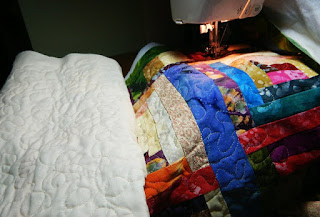It starts with paper piecing for the squares. In pioneer times it would have been fabric, numbered and ruled.Gives the squares a lot of stability.
Stitching on the back side of the pattern.
Using a light to see ow the fabric lies in relation to the lines.
Then it's stitch. Dark and Light. The spokes and logs. Stitch and Stitch and Stitch....
Checking to see how it lines up.
Trimming as you go along, so that there isn't too much fabric hanging around.
Pressing the log cabin squares.
You can see the sunshine and shadows forming.
Even Bo wants in on everything. She loves the "Happy Lite" I use for sewing.
This was my first format. All Log Cabin blocks. But wasn't crazy about it.
I was trying to keep it to 68 inches. It was a tad longer than I wanted.
Time for the border. I had a good look at other patterns,and decided on "piano keys". That meant sewing strips of fabric together till I had a long segment.
I changed the middle square to a batik "Fox and Geese" square. I thought it made the runner settle better, with the log cabin on the outside.
Then the border was added. Fabric cut into "keys" like a piano keyboard.
And stripped with a great green. Makes everything pop. The first signed Log Cabin quilt was discovered in 1869.These days I just sew my label into the corner.
Time to back and fill. I like a fairly flat filler for runners. Easier to machine quilt.
My two cats, Bo and Bunny were extremely helpful.
Though, Bunny forgot her duties and went to the door to see Smokey.
Then it was back at the batting and the backing. I discovered, when I was reading up on this quilt, that there were Log Cabin designs from the 1700's in Scotland.I had no idea. I thought it was fairly recent.
But the earliest Log cabin pattern can be found in Egypt, on the mummies of animals. The unmistakable pattern of interlocking log cabin wrapped around the bodies. I would like to know who was the enterprising soul who noticed it.
Machine quilting is something I never used to do. But I have discovered Free Arm quilting. It's fast and fabulous!
And in about two hours can do a runner like this ( 68x32") so quickly.
For binding I used up leftover strips, so sewed a ton of different fabrics together. I didn't cut on the bias, too fussy for me. I just strip them straight on, then iron the edge and sew it onto the quilt.
From start to finish this large wide runner took about five days to make.
All covered with swirlies.
Awash with batik, log cabin sings. And it's Bunny approved....




















































